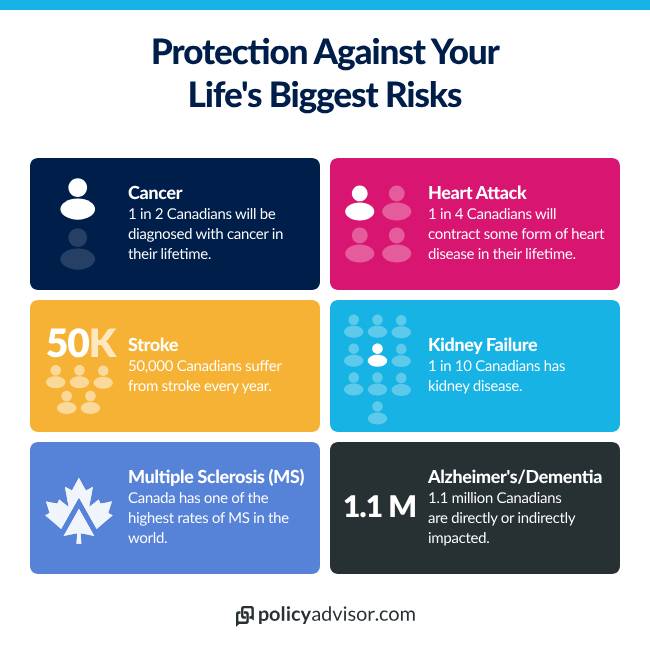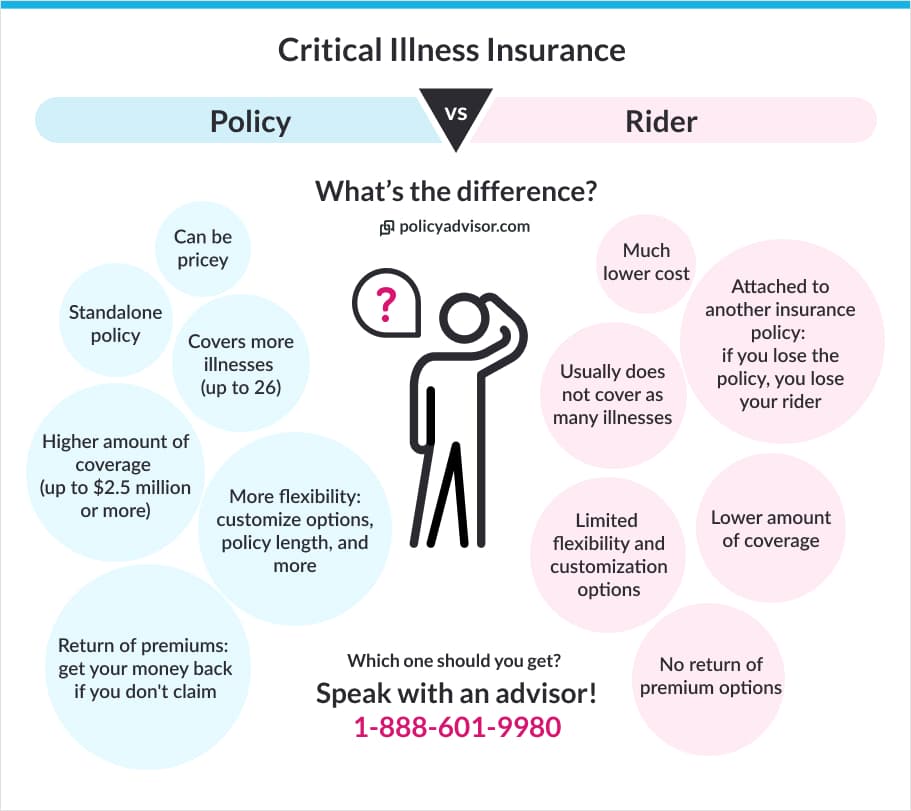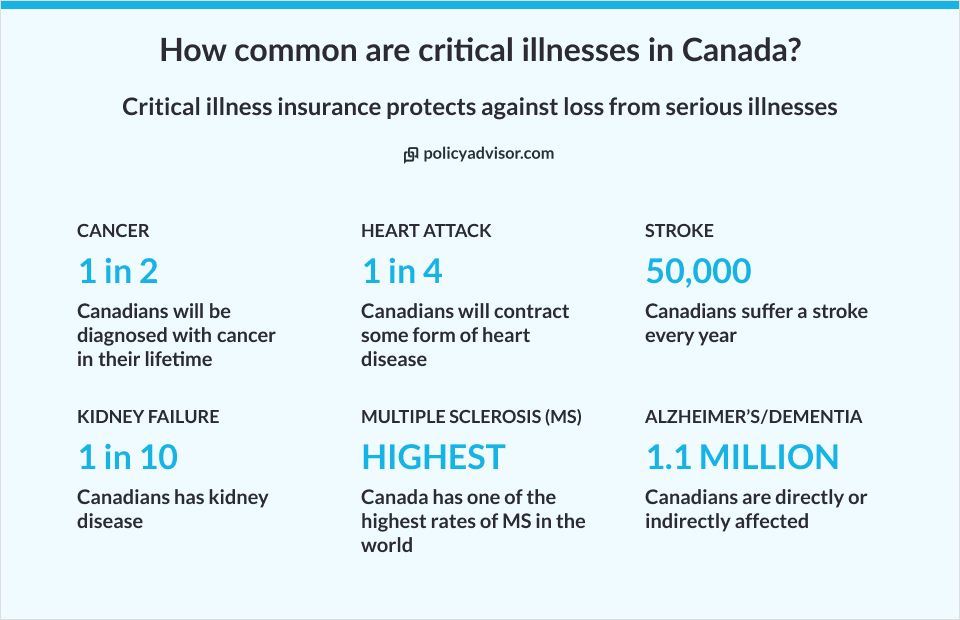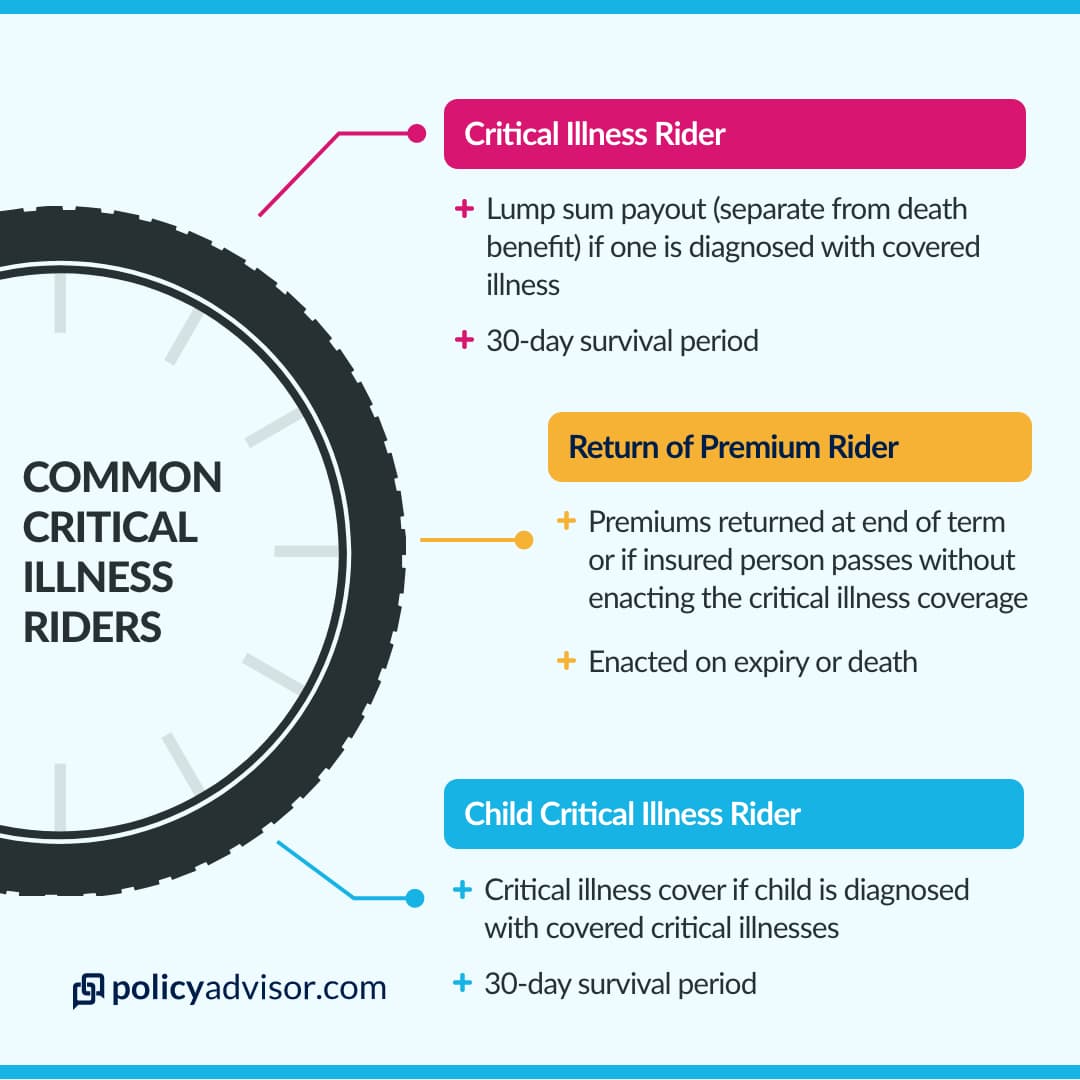According to the Canadian Cancer Society, nearly 1 in 2 Canadians will face cancer or any other critical illness in their lifetime. While the Canadian healthcare covers many medical expenses, a critical illness like cancer or a stroke can leave you with huge medical bills, lost income, and extra expenses. That’s where critical illness insurance can save you by paying a lump sum if you are diagnosed with a covered critical illness, so you can focus on your recovery without stressing over money.
But with so many options available, how do you find the most affordable critical illness coverage in Canada? This article will guide you to the best and cheapest critical illness insurance companies in Canada and how to get the best plan within your budget.
What is critical illness insurance?
Critical illness insurance pays you a tax-free lump sum amount if you are diagnosed with a critical illness listed in your policy. A few common critical illnesses are cancer, stroke, heart attack, multiple sclerosis, etc. The insurer pays this lump-sum money directly to you and can be used for covering your medical bills, paying your mortgage loan, or replacing your lost income while you recover.
Critical illness insurance is different from life insurance as it supports you financially while you are still alive and dealing with a serious health condition. The main purpose of this coverage is to reduce your financial burden so you can focus on recovering from your critical illness.
What factors influence critical illness insurance cost in Canada?
Insurers take several factors into account while deciding the coverage and cost of your insurance premium. These include your age, health and medical history, smoking status, policy term, lifestyle, and occupation. Take a look at some key factors:
- Age: Older people pay a higher premium as the risk of developing a critical illness increases with age
- Medical history: If you have a pre-existing condition or a history of illness, you may have to pay higher premiums or even face denial of coverage
- Term of policy: Longer policy terms often result in higher premiums
- Coverage amount: The higher the coverage amount you choose, the higher your CI insurance cost
- Smoking status: If you are a smoker, you may have to pay a higher premium due to the increased risk of critical illness
- Lifestyle and occupation: Risky occupations or unhealthy lifestyle habits, such as heavy alcohol use, can also raise your premiums
- Family medical history: A family history of critical illnesses can also raise premium costs as insurers consider this a high risk
What are the cheapest critical illness insurance companies in Canada?
Some of the most affordable and best critical illness insurance companies in Canada are BMO Insurance, Canada Protection Plan, Manulife, and RBC Insurance.
Here is a list of top insurance companies that offer low-cost critical illness insurance for some major illnesses, such as cancer, heart attack, kidney failure, stroke, and multiple sclerosis.
- RBC Insurance: Cheapest critical illness insurance for heart attack and stroke
- Canada Protection Plan: Cheapest critical illness insurance for cancer
- Manulife: Cheapest critical illness insurance for kidney failure
- BMO Insurance: Cheapest critical illness insurance for multiple sclerosis and brain tumours
Cheapest critical illness insurance for heart attack and stroke: RBC Insurance
RBC offers a basic critical illness insurance plan, which is one of the most affordable for those who mainly want coverage for common serious illnesses like stroke and heart attack. This critical illness plan is ideal for those 18-50 years old.
Under this plan, you can choose a lump-sum benefit of $10,000, $25,000, $50,000, or $75,000, depending on your financial needs.
RBC critical illness insurance monthly premiums
| Age | Estimated monthly premium |
| 25 | $13–$15 |
| 30 | $15–$18 |
| 35 | $18–$22 |
*Representative monthly premium for a healthy, non-smoking 30-year-old, $50,000 coverage
Cheapest critical illness insurance for cancer: Canada Protection Plan
Canada Protection Plan offers a specific “Cancer Protect” plan, which is one of the budget-friendly cancer insurance coverage plans. The typical coverage offered under this plan is a $10,000 to $50,000 lump-sum benefit. Though this plan is focused on cancer, but also offers combined plans for both cancer and heart conditions.
The Cancer Protect plan is best-suited for those who want cheap coverage, especially for cancer, with an easy application process.
CPP critical illness insurance monthly premiums
| Age | Estimated monthly premium |
| 25 | $10–$13 |
| 30 | $12–$15 |
| 35 | $15–$18 |
*Estimated monthly premium for a healthy, non-smoking 30-year-old, $50,000 coverage
Cheapest critical illness insurance for kidney failure: Manulife
Manulife’s basic critical illness insurance plan, CoverMe, is among the most affordable plans for kidney failure. This plan is not only affordable but also does not require any medical exam for approval. The policy offers a lump sum, tax-free benefit up to age 75.
The CoverMe plan focuses on the most common and severe illnesses, which makes it one of the cheapest plans for critical illness. Apart from kidney failure, it also covers major illnesses like cancer, heart attack, stroke, coronary artery bypass surgery, and aortic surgery
Manulife critical illness insurance monthly premiums
| Age | Estimated monthly premium |
| 25 | $24 |
| 30 | $27 |
| 35 | $27 |
| 40 | $30 |
| 45 | $34 |
| 50 | $38 |
*Estimated monthly premium for a healthy, non-smoking 30-year-old, $50,000 coverage
Cheapest critical illness insurance for multiple sclerosis and brain tumours: BMO Insurance
BMO Insurance offers a cheap critical illness insurance plan for multiple sclerosis and benign brain tumours, with 25 other illnesses including cancer, heart attack, stroke, and alzheimer’s. If you want coverage for these two conditions, BMO insurance is the most affordable insurer.
The Living Benefits critical illness policy offers 10- and 20-year terms or coverage up to 75 or 100 years of age. Apart from multiple sclerosis and brain tumours, this plan also covers 25 other life-threatening conditions at affordable costs.
BMO critical illness insurance monthly premiums
| Age | Estimated monthly premium |
| 25 | $18–$20 |
| 30 | $20–$22 |
| 35 | $22–$25 |
*Estimated monthly premium for a healthy, non-smoking 30-year-old, $50,000 coverage
How to lower critical illness insurance cost in Canada?
To find the most affordable critical illness insurance in Canada, you can follow a few practical steps. These include comparing quotes, choosing basic coverage, applying when you are young, opting for lower coverage amounts, and consulting with an insurance broker.
- Shop around: The critical illness insurance rates for similar coverage may vary from insurer to insurer. So, it would be best to shop around and compare plans from multiple life insurance providers. If this seems a difficult task for you, you can also visit PolicyAdvisor and compare plans from multiple insurers in one place
- Apply when you are young: Critical illness insurance premiums are typically cheap when you are younger and in better health. To get the most affordable plans, apply when you are young
- Limit coverage amount: Going for a higher coverage amount will automatically increase your premium. Opt for a basic critical illness plan with lower coverage amounts to save up on premiums
- Consider policy riders: Some insurers also let you add critical illness coverage as a rider to your life insurance policy. This way, you can get the needed coverage at a much lower cost than buying a standalone policy
- Limit the coverage term: Instead of going for lifetime coverage, limit your policy term for say 10 or 20 years, i.e., for the time when you may need it. Having short-term critical illness insurance will be cheaper than lifetime coverage
How do pre-existing conditions affect the cost of critical illness insurance?
Pre-existing conditions can significantly impact the cost of critical illness insurance in Canada. If you have a medical history involving chronic illnesses like diabetes, hypertension, heart disease, or cancer, insurers will assess you as a higher-risk applicant. As a result, they might:
- Charge higher premiums if you have a history of illnesses like asthma, thyroid disorders, or autoimmune conditions
- Exclude specific illnesses related to your medical history from the policy’s coverage
- Ask you to undergo additional medical tests or detailed underwriting to assess your current health status
- Decline your application if you’ve had recent diagnoses or complications from serious conditions
The impact on your premium depends on the type and severity of the condition, how well it is managed, and how long it has been stable. Applicants with stable pre-existing conditions may still qualify for coverage.
Are critical illness insurance premiums tax-deductible in Canada?
In Canada, critical illness insurance premiums are generally not tax-deductible for individuals when the policy is personally owned. This means that if you buy a critical illness policy to protect yourself or your family, you cannot claim the premiums as a tax deduction on your personal income tax return.
However, if a business purchases a policy for an employee, the premiums might be considered a business expense, depending on how the policy is structured and who the beneficiary is. It’s important to consult a tax advisor or accountant to understand the tax implications, especially if you’re self-employed or a business owner offering employee benefits.
Is it cheaper to bundle life and critical illness insurance in Canada?
Yes, bundling life and critical illness insurance in Canada can be cheaper than buying two separate policies. Many insurers offer bundled plans at discounted rates, making it a cost-effective way to get comprehensive protection.
When you bundle, you typically pay a single premium for both coverages, which reduces administrative fees and simplifies policy management. Some insurers even offer flexible options to customize the coverage amounts for life and critical illness separately.
For example, you might choose $250,000 in life insurance with $50,000 in critical illness coverage under one plan. Bundling also ensures that both policies work seamlessly together, offering financial protection for both death and serious illnesses like cancer or stroke. Speak to a licensed advisor to explore bundle options and savings
Is it worth paying for critical illness insurance?
Yes, critical illness insurance can be a worthwhile investment in Canada, particularly if you:
- Don’t have employer-provided insurance or benefits
- Have a family history of serious illnesses
- Want to ensure your mortgage or other financial obligations are covered if you lose income due to illness
When it comes to affordability, critical illness insurance is relatively accessible, with premiums starting as low as $24 per month. However, costs may vary based on your age, health, smoking status, and the level of coverage you choose.
If you’re worried about critical illness insurance not being worthwhile, you can add a return of premium rider to your plan. This option will return all your paid premiums if:
- You pass away without making a claim
- Your policy expires without a claim
- You cancel your policy after a set period without a claim
How to get the cheapest critical illness insurance in Canada?
Finding the most affordable critical illness insurance in Canada can feel overwhelming, especially when you’re comparing multiple plans without knowing the fine print. That’s where PolicyAdvisor makes a difference.
Our licensed advisors work with 30+ top Canadian insurance companies to compare quotes and coverage options tailored to your needs and budget. We simplify the process, helping you understand your options clearly and choose the most cost-effective plan without any pressure or hidden fees.
Even after you purchase your policy, our team provides dedicated after-sales support, answering any questions and assisting with future changes or claims. Book a free consultation with us today to secure the best critical illness insurance coverage at the lowest possible price.
Frequently Asked Questions
Is having critical illness insurance worth it in Canada?
Yes, having critical illness insurance can be worthwhile as it can provide you with the much-needed financial support when you are dealing with a life-threatening condition. It will offer a lump-sum payment to help cover medical expenses, supplement lost income, and provide monetary support to your family.
Can I get critical illness insurance if I have a pre-existing condition?
Yes, you can get critical illness insurance even if you have a pre-existing condition. However, having a pre-existing condition may affect your policy premium and its terms. You may have to go through a waiting period and get limited coverage. So, make sure to check the policy wordings before proceeding.
How do I get cheap critical illness insurance in Canada?
To get the best critical illness insurance in Canada, you can follow a few basic steps. These include:
- Applying when young and healthy
- Shopping around and comparing critical illness insurance quotes from insurance brokers like PolicyAdvisor
- Go for basic plans with limited coverage
- Opting for a limited time (such as 10, 20 years) policy
If I already have a life insurance policy, do I still need critical illness coverage?
Life insurance and critical illness cover both serve different purposes. While life insurance pays you a death benefit if you pass away, critical illness cover pays a lump sum amount while you are alive and dealing with a serious illness, like a heart attack, cancer, stroke, to name a few. This lump sum money can help you with recovery and daily expenses while you are dealing with a critical illness.
How is critical illness insurance different from disability insurance?
Disability insurance provides a monthly income replacement if you can’t work due to injury or illness for a period of time. It gives you a monthly payment until you feel better and return to work. Critical illness insurance provides a one-time lump sum payment if you are diagnosed with a serious illness mentioned in your policy. Whether you can work or not, this policy will pay you a lump sum amount upon diagnosis.


 1-888-601-9980
1-888-601-9980






